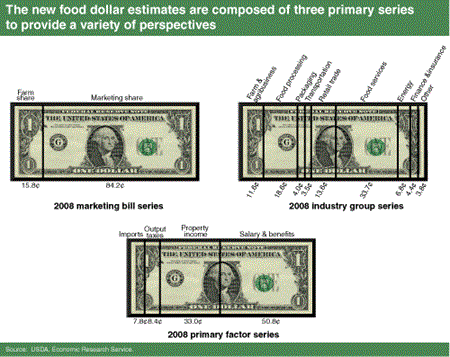A New Look at Where Our Food Dollars Go
The ERS marketing bill has been a popular statistical series for food market observers interested in knowing the costs of getting food from farm to table. The marketing bill series identified the costs of processing and marketing the raw farm commodities contained in a typical dollar's worth of U.S.-produced food and the share going to farmers. However, it is no longer possible to use the longstanding method for estimating the annual marketing bill because many of the data sources have been discontinued and the estimation procedures do not fully represent today's food economy.
In February 2011, ERS introduced a new data product called the food dollar series that uses the Bureau of Labor Statistics' annual input-output tables to provide a more complete accounting of U.S. food spending at both grocery stores and eating places. The new food dollar estimates are composed of three primary series that slice the same food dollar differently to provide a variety of perspectives. The new series spans 1993 to 2008 and will be updated annually.
A comparison of related statistics between the new and older series highlights some important changes in ERS's assessment of what food dollars pay for:
- The marketing bill series, like the previous series of that name, identifies the distribution of the food dollar between farm and marketing shares. Like the old series, the new marketing bill series exhibits an increasing trend in marketing costs in most years since 1993. However, the new measure of these costs averaged nearly 4 cents higher per food dollar each year from 1993 to 2006 than estimates of the old marketing bill series. New data and better estimation methods explain this difference.
- The primary factor series identifies the distribution of the food dollar in terms of U.S. workers' salaries and benefits, rents to food industry property owners (property income), output taxes, and imports. The salaries and benefits of all U.S. workers who play a role in the agriculture/food system declined 4 cents to roughly 50 cents of the food dollar in 2001-08, according to the new primary factor series. Labor costs in the old series reflected the salaries and benefits of only processing, wholesaling, retailing, and foodservice workers. These salaries and benefits accounted for around 38 cents of the food dollar during 2001-06.
- The industry group series identifies the value added, or cost contributions, to the food dollar by 10 distinct segments of the food supply chain. In this series, energy industry cost contributions to each food dollar went from about 4 cents in 1998 to 6.8 cents in 2008 and reflect energy use throughout the food system--from farm inputs to the grocery store or eating place. The old marketing bill series, which only reported energy costs from fuel and electric utilities of processing, wholesaling, retailing, and foodservice companies, indicated these costs were steady at roughly 3.5 cents in 1998-2006. Other energy costs in the old series were embedded in other cost categories. For example, fuel costs for transporting food and ingredients were part of transportation costs. The farm and agribusiness share in the industry group series differs from the farm share in the marketing bill series because farmers' costs for energy, transportation, and other nonagribusiness expenses have been deducted from the farm share in the industry group series. In 2008, those expenses totaled 4.2 cents of the 15.8-cent farm share of the food dollar, leaving an 11.6-cent farm and agribusiness industry group share.
Expanded Food Dollar Series Offers New Insights
ERS's new food dollar series disaggregates at-home and away-from-home food spending to illuminate the diverse expenditure and cost dynamics in these two markets.
- For all food spending, the farm share in 2008 was 15.8 cents. However, increasing foodservice costs have pushed the farm share of the away-from-home food dollar below 5 cents.
- Marketing costs for food-at-home spending have held steady, keeping the farm share of at-home food spending at around 23 cents since 1993.
- High foodservice costs, particularly for labor, dominate other cost categories in the away-from-home food dollar. These other costs are more pronounced in the food-at-home dollar. For example, imported inputs, such as petroleum, fertilizers, and food ingredients, represented 9.7 cents of each at-home food dollar spent on domestically produced food in 2008 but only 5.4 cents of each away-from-home dollar.
ERS also calculates the same three primary series, along with at-home and away-from-home disaggregations, for a 'food and beverage' dollar that includes soft drinks and alcoholic beverages. In addition, statistics for all series are reported in both nominal and real (inflation-adjusted) dollars.
| Industry group | Total (all factors) | Salary and benefits | Property income | Output taxes | Imports |
|---|---|---|---|---|---|
| Total (all industry groups) | 100.0 | 46.8 | 35.5 | 8.0 | 9.7 |
| Farm and agribusiness | 18.3 | 4.5 | 11.1 | 0.5 | 2.1 |
| Food processing | 30.1 | 17.7 | 9.1 | 1.5 | 1.8 |
| Packaging | 4.9 | 2.1 | 1.2 | 0.2 | 1.4 |
| Transportation | 5.1 | 2.9 | 1.6 | 0.2 | 0.4 |
| Retail trade | 24.2 | 13.3 | 5.7 | 4.6 | 0.6 |
| Foodservice | 0.9 | 0.5 | 0.3 | 0.1 | 0.0 |
| Energy | 8.2 | 1.5 | 2.8 | 0.7 | 3.2 |
| Finance and insurance | 4.7 | 2.4 | 2.1 | 0.2 | 0.2 |
| Advertising | 1.9 | 0.9 | 0.8 | 0.1 | 0.1 |
| Legal and accounting | 1.7 | 1.0 | 0.7 | 0.1 | 0.0 |
| Totals may not add due to rounding. Source: USDA, Economic Research Service. |
|||||
A Revised and Expanded Food Dollar Series: A Better Understanding of Our Food Costs, by Patrick Canning, USDA, Economic Research Service, February 2011
Food Dollar Series, by Quinton Baker and James Chandler Zachary, USDA, Economic Research Service, November 2023



